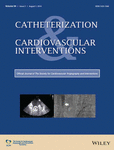Journal list menu
Export Citations
Download PDFs
ISSUE INFORMATION - COPYRIGHT
ISSUE INFORMATION - EDITORIAL BOARD
ISSUE INFORMATION - TOC
PRESIDENT'S PAGE
CORONARY ARTERY DISEASE
Original Studies
no
Predictors of mortality in patients with non-anterior ST-segment elevation myocardial infarction: Analysis from the HORIZONS-AMI trial
- Pages: 172-180
- First Published: 28 January 2019
no
Personalized antiplatelet therapy in patients with coronary artery disease undergoing percutaneous coronary intervention: A network meta-analysis of randomized clinical trials
- Pages: 181-186
- First Published: 10 January 2019
no
Impact of calcification on percutaneous coronary intervention: MACE-Trial 1-year results
- Pages: 187-194
- First Published: 25 January 2019
no
The influence of Elixhauser comorbidity index on percutaneous coronary intervention outcomes
- Pages: 195-203
- First Published: 10 January 2019
no
Comparison of neointimal coverage between durable-polymer everolimus-eluting stents and bioresorbable-polymer everolimus-eluting stents 1 year after implantation using high-resolution coronary angioscopy
- Pages: 204-209
- First Published: 09 February 2019
no
Bivalirudin with a post-procedure infusion versus heparin monotherapy for the prevention of stent thrombosis
- Pages: 210-215
- First Published: 13 January 2019
no
In vivo validation of Dosemap software use in interventional cardiology with dosimetrics indicators and peak skin dose evaluation
- Pages: 216-222
- First Published: 04 February 2019
Case Report
no
Emergency treatment of iatrogenic coronary perforation by transcatheter embolization with gelatin sponge particles—Description of technique
- Pages: 223-226
- First Published: 19 April 2019
Editorial
no
Conversation in cardiology: Is there a need for clinical trials for the nonhyperemic pressure ratios?
- Pages: 227-232
- First Published: 20 May 2019
PEDIATRIC AND CONGENITAL HEART DISEASE
Original Studies
no
Comparison of drug eluting versus bare metal stents for pulmonary vein stenosis in childhood
- Pages: 233-242
- First Published: 08 May 2019
PERIPHERAL VASCULAR DISEASE
Original Studies
no
Percutaneous transaxillary approach for peripheral endovascular interventions
- Pages: 243-248
- First Published: 27 May 2019
no
Association of peripheral artery disease with in-hospital outcomes after endovascular transcatheter aortic valve replacement
- Pages: 249-255
- First Published: 25 April 2019
no
Functional hemodynamics assessment during endovascular Tibio-pedal retrograde intervention of peripheral arterial disease
- Pages: 256-263
- First Published: 15 May 2019
VALVULAR AND STRUCTURAL HEART DISEASES
Original Studies
no
Transradial versus transfemoral percutaneous coronary intervention of left main disease: A systematic review and meta-analysis of observational studies
- Pages: 264-273
- First Published: 10 December 2018
Case Report
no
When the pressure drops: A case of vasoplegia during a structural heart intervention
- Pages: 280-284
- First Published: 25 April 2019
no
Technical aspects of a successful transvascular retrieval of an acutely dislodged WaveCrest® left atrial appendage occluder
- Pages: 285-288
- First Published: 18 June 2019
Clinical Decision Making
Free Access
free
Bridging gaps in heart valve disease care: Opportunities for quality improvement
- Pages: 289-293
- First Published: 24 June 2019
Editorials
no
Hemodynamics: The heart of catheterization and cardiovascular interventions
- Page: 294
- First Published: 04 August 2019
no
Preface to the series: Introduction to hemodynamic rounds
- Page: 295
- First Published: 24 July 2019
Hemodynamic Rounds
no
Mixed aortic valve disease treated with transcatheter aortic valve replacement in a high risk patient presenting with acute decompensated heart failure
- Pages: 296-300
- First Published: 10 April 2019
Key points
- Mixed aortic valve disease refers to the combination of aortic regurgitation (AR) and aortic stenosis (AS).
- Common etiologies include bicuspid aortic valve, rheumatic heart disease, and endocarditis superimposed upon a stenotic aortic valve.
- Hemodynamic findings of mixed aortic valve disease demonstrate findings of both AR and AS with a delayed aortic upstroke in the setting of other hemodynamic features of AR (wide pulse pressure, low aortic end diastolic pressure)
- Assessment of left ventricular end diastolic pressure (LVEDP) can be useful to determine whether the volume overload of AR is well-tolerated by the left ventricle. A normal LVEDP suggests the volume overload is well tolerated and chronic in duration. In contrast, an elevated LVEDP suggests that the volume overload is not well-tolerated and is more acute in duration.
- Patients with long-standing, chronic AR may develop a sudden worsening either from a superimposed process or when the left ventricle is no longer able to further dilate to accommodate the regurgitant volume. In this setting, the hemodynamics may appear similar to acute AR.
- Transcatheter aortic valve replacement (TAVR) represents a new treatment option for patients with mixed aortic valve disease deemed high risk or nonoperable for surgical aortic valve replacement.
no
Evaluation of the severity of mitral stenosis in patient with pulmonary hypertension: Role of exercise hemodynamics
- Pages: 301-307
- First Published: 27 June 2019
Letters to the Editor
no
Economical cost of percutaneous vascular closure with ProGlide™ and Prostar™ XL following transcatheter aortic valve replacement
- Pages: 308-309
- First Published: 22 October 2018
no
Paravalvular leak closure after valve in mitral annular calcification: Better to avoid leaks
- Page: 310
- First Published: 19 March 2019
CORONARY ARTERY DISEASE
Letters to the Editor
no
Letter to the editor regarding the original article by Gianluca Rigatelli et al. presenting novel stenting technique for complex coronary bifurcation
- Page: 311
- First Published: 21 February 2019
CORONARY ARTERY DISEASE (E-only Article)
Original Studies
no
Usefulness of longitudinal reconstructed optical coherence tomography images for predicting the need for the reverse wire technique during coronary bifurcation interventions
- Pages: E54-E60
- First Published: 25 November 2018
no
Feasibility and safety of jailed-pressure wire technique using durable optical fiber pressure wire for intervention of coronary bifurcation lesions
- Pages: E61-E66
- First Published: 05 February 2019
no
Frequency of 30-day readmission and its causes after percutaneous coronary intervention in acute myocardial infarction complicated by cardiogenic shock
- Pages: E67-E77
- First Published: 27 February 2019
Case Report
no
The combined use of stent retriever and neuro-aspiration as successful bail-out reperfusion strategy in a patient with embolic myocardial infarction
- Pages: E78-E81
- First Published: 09 March 2019
VALVULAR AND STRUCTURAL HEART DISEASES (E-only Article)
Original Studies
no
Percutaneous edge-to-edge mitral valve repair may rescue select patients in cardiogenic shock: Findings from a single center case series
- Pages: E82-E87
- First Published: 24 January 2019
Interventional Rounds
no
Comparison of transcatheter and surgical treatment of paravalvular leak: Results from a 5-year follow-up study
- Pages: E88-E95
- First Published: 07 December 2017





